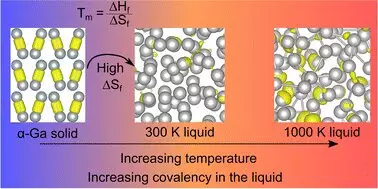Gallium is not just an ordinary metal; it has a rich history spanning nearly 150 years since its discovery. Identified by the French chemist Paul-Émile Lecoq de Boisbaudran in 1875, gallium is renowned for its unique properties, particularly its low melting point. An interesting quirk of this metal is that a gallium spoon can literally dissolve in a cup of tea, showcasing its remarkable characteristics that set it apart from conventional metals. Yet, despite its lengthy presence in the scientific lexicon, gallium has continued to yield unexpected surprises regarding its atomic behavior, revealing an intricate and puzzling nature that even seasoned scientists seem to overlook at times.
The Unraveled Mystique: Gallium’s Atomic Behavior
Recent groundbreaking research conducted by scientists at the University of Auckland has uncovered significant complexities in gallium’s atomic structure and behaviors. This investigation challenges prior assumptions about the metal, particularly at the atomic level. Unlike the majority of metals that exist as single atoms in solid form, gallium exhibits a peculiar configuration known as ‘dimers’—pairs of atoms that bond with one another. This unique attribute raises deeper questions about how gallium transitions between its liquid and solid states.
Adding to its mystique, gallium’s solid state is less dense than its liquid state, reminiscent of ice floating on water. This behavior alone complicates our understanding of metallic properties, generally characterized by consistency in density across states. The newly published study, “Resolving Decades of Debate: The Surprising Role of High-Temperature Covalency in the Structure of Liquid Gallium,” reveals that gallium’s covalent bonds—where atoms share electrons—vanish right as the metal melts and intriguingly reappear at elevated temperatures. Professor Nicola Gaston highlights a paradigm shift: “Thirty years of literature on the structure of liquid gallium has had a fundamental assumption that is evidently not true.” This statement denotes a seismic shift in understanding with profound implications for various technological realms.
Entropy: The Hidden Key to Gallium’s Properties
A significant aspect of this research is the role of entropy, a measure of disorder within a system. The scientists propose that the sudden disappearance of covalent bonds as gallium reaches its melting point corresponds with a significant increase in entropy. This finding presents a compelling case for why gallium defies typical metallic expectations, presenting a shift not merely in physical behavior but also in the underlying principles governing atomic interactions.
Such revelations need delving into, particularly in fields like nanotechnology, where understanding the microcosm of matter manipulation is paramount. The ability to precisely control and model materials at the atomic level ignites innovation in the production of new materials, essential for areas such as electronics and renewable energy solutions. As gallium continues to play a vital role in various industries—from semiconductors to telecommunications—this newfound comprehension may pave the way for groundbreaking advancements.
Gallium’s Broad Applications: From Earth to Mars
The applications of gallium reach far beyond the confines of traditional usage. Its presence is vital across numerous modern technologies, including solar panels, LEDs, and advanced computing systems. Whether serving as a safer alternative to mercury in thermometers or facilitating complex liquid metal reactions, gallium remains an integral element of our technological landscape.
The recent revelations extend their implications beyond Earth, with researchers eyeing gallium as a potential chemical marker that could hint at the existence of past life on Mars. As scientists probe the Martian surface, gallium may hold the key to understanding primordial microbial life and how its byproducts could persist within the planet’s geology. In an age of interplanetary discovery, this metal’s unexpected role as an extraterrestrial detective may further alter its scientific narrative.
Reflecting on Gallium’s Legacy
While gallium’s historical significance is well recognized, its ongoing evolution within scientific inquiry illustrates an essential truth: the world of science is ever-unfolding. Each new discovery, such as those made by researchers like Dr. Steph Lambie and Professor Nicola Gaston, underscores the importance of continuous questioning and exploration. Their meticulous examination of past literature and innovative comparisons have not only dismantled long-held misconceptions but stitched together a richer understanding of a metal that has, metaphorically and literally, melted expectations.
As the inquiry into gallium’s atomic behavior progresses, it raises exciting possibilities for the future of material science and various technological applications. The age of gallium may indeed be just beginning, unfolding its mystique one layer at a time.

